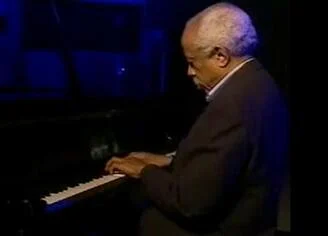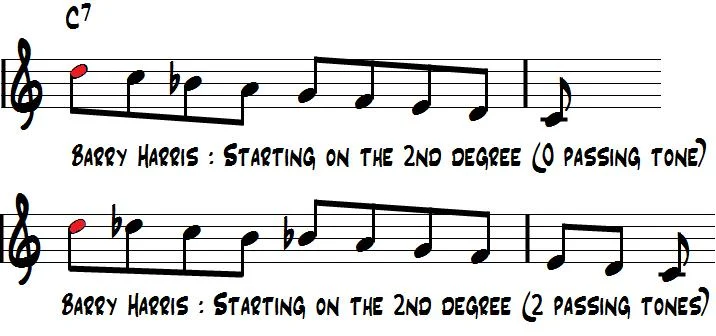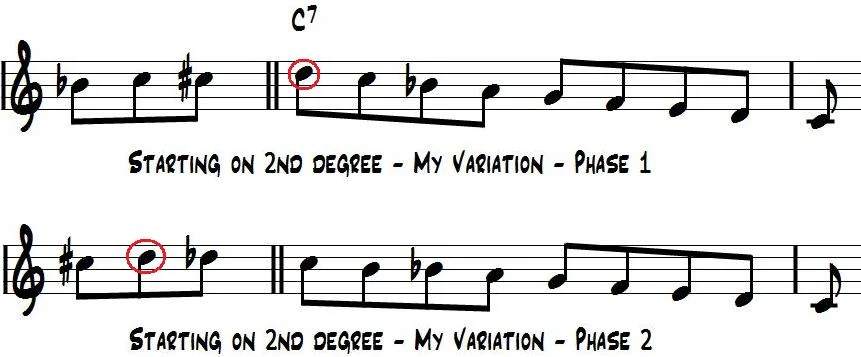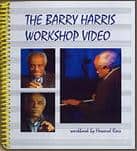Barry Harris Half-Step Practice Model for Bebop Scales
Sep 02, 2020I developed these advanced exercises after studying the interesting material from The Barry Harris Workshop DVD and Barry Harris Harmonic Method for Guitar

After a while of practicing the Half-Step Practice Model (as explained in the Barry Harris Workshop DVD booklet), I finally made up some of my own exercises.
Before we begin I suggest getting familiar with the bebop scale before starting
If you have never encountered bebop scales, start by practicing "in time" with this sample rhythm exercise. It employs NO passing tone and is based on C dominant 7th (mixolydian) scale.
Don't know what a bebop scale is or want to learn more about it?
Watch this video.
Part one: Learning the Model
What is the "Practice Model" ?
Without going into too much detail (no spoiler alert here!). Barry Harris has a way of making scales "fit" into bar lines which he calls:
The Half-Step Practice Model.
This concept stems from the bebop language ... and it's all about rhythms.
In short, the model is a technique that adds 0, 1, 2 or 3 extra passing notes to regular scales. The end result is the rhythmical alignment of "strong notes on strong beats" within the bar.
This simply means that we get chord-tones 1-3-5-7 on downbeats.
The three optional passing notes can be found between degree b7 and 3 (in a mixolydian scale). The passing notes are shown in red:

Now lets' get a little more advanced.
The Bebop Scale
The primary scale which is, by the way, a great starting point for most teachers (including yours truly). It is most commonly referred to as "bebop scale" and only has ONE passing note between b7 and 1 (in this case, the "B natural" note).
The most basic bebop scale is therefore:

However, the Barry Harris Workshop goes beyond this simple scale by using two more available passing-tones. Let's say you wanted to start the scale on something other than the root, it wouldn't always work! Give it a try!
So Barry found a solution to this musical problem...
Zero and Two Passing Tones
Let use the "F" (the fourth degree) as an example in the same old, C7 mixolydian scale. You can have either:
1. NO passing tone added

or
2. Two passing tones!

As you can see, the arrows point to chord tones. Notice how they fall on downbeats after the scale is "rebalanced" because of the presence (or absence) of passing tones.
One and Three Passing Tones
One more example: starting on the 3rd ("E" note). You can have either:
1. One passing tone

or
2. Three passing tones!

By now, I think you get the idea...
This is just a principle, of course. You have to own the Barry Harris Workshop DVD to really "get it" and understand how it works. It always better to hear the master himself explain it to you!
Part two: Implementation
What am I doing different from Barry ?
So, yes: I like the idea behind Barry's Half Step Practice Model very much. I've been working with the Barry Harris Workshop DVDs for years now. And yes: I even took the time to write my very own exercises (in mixolydian only) based on the whole approach.
Here's what I'm adding.
My variations on the original concept:
- Each line starts with a pickup of three 8th-notes and
- Each scale degree is treated in two "phases" :
i. Placed on beat "one" (after the pickup)
ii. As part of the pickup (beat "four")
Confused?
Basically, if you play them "my way" you'll get all the musical juice from the original Barry Harris Workshop exercises plus a few added bonuses. A picture is worth a thousands notes, so here's an example.
I turned this (Original "Barry Harris Workshop" way):

... into this (Phase one and Phase Two)

Ready?
See below (and the video) for the complete set of exercises. Don't forget to read the practice suggestions!
The Entire Exercise Sheet Music: Scales from different degrees using pickups
Without further ado...
Here is the complete PDF
Download Barry Harris Half-Step Practice Model for Bebop Scales
Join our Community here.
Part three: Tips
Practice suggestions
Go very slow! Use a metronome and learn the lines at ridiculously slow speeds. This is like "programming" the lines into your ears and fingers.
Repetition: Repeat one line as much as you to need to memorize it. Test yourself: stop looking at the paper and play the line!
Fingerings: Use the suggested fingerings (in TABS) or come up with your own. But, whatever you do, stick to the same fingerings for a while. It becomes easier to "ingrain" lines in working in this fashion; you may always fix your fingerings later.
Octave: You can start most lines at different octaves on the guitar. I wrote down only basic starting points here. See how far up (and/or down) the fretboard you can go with the same line.
Analyze and Investigate: How many passing notes are present in the line and why? Can you invent some variations on this line?
Etude: Once each line is memorized individually, play the entire thing, front to back as an etude.
Practice Phase 1 separately from Phase 2: Then practice them together... in the end, you'll realize they're the same old thing!
Chromatics: The chromaticism in the pickups can be changed to suit your taste/style. I'm sure you could come up with many different interesting pickups. (as I'm barely scratching the surface here, with only the most obvious ones...)
Discard the paper: Learn the two pages by heart!
Learn in all keys: Play through cycle of fourth, at first.
i. The whole page in different keys or ...
ii. Play one line at a time in 12-keys
Don't forget to check out this literature ... (The Barry Harris Workshop DVDs and The Alan Kingstone Book on the Barry Harris Harmonic Method)











